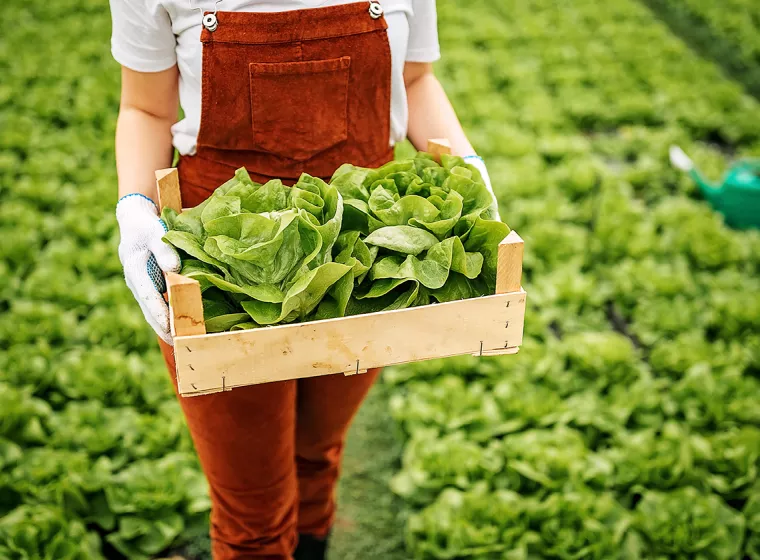February 10, 2022
Integrative and systematic approaches to evaluating operational impacts
We don't often ponder the environmental impact of our food — whether that's a carton of yogurt, the hamburgers on your grill, a can of mushroom soup, or the lettuce in your salad.
Producing food requires resources, such as land, water, energy, and fuel, while creating by-products that can impact the environment, including methane, carbon dioxide, and nitrous oxide. In fact, the global food system from production to consumption, including processing, transport, and packaging, accounts for an estimated one-third of total global greenhouse gas emissions.
Regardless of where they are on the food supply chain, food system operators — from producers, manufacturers, processors, and storage facilitators to distributors and retailers — form complex networks that are under increased pressure from the public, investors, and regulators to develop more environmentally sustainable practices. Many companies are already voluntarily reporting their environmental, social, and governance (ESG) commitments to show their dedication to responsible practices while adding to product value and reducing reputational risks.
Scrutiny is likely to increase, in part due to the 26th United Nation's Climate Change Conference of the Parties (COP26) held in Glasgow last October. At COP26, nations renewed their commitment to implementing national plans with 2030 emissions reductions targets to reach net zero by mid-century.
Given that renewed environmental commitments from COP26 will likely result in policy and legislative changes affecting all sectors, food system stakeholders are being challenged to develop sustainability goals that not only demonstrate environmental compliance and social responsibility but also show they are producing safe and healthy food.
Know what you're labelling
One way to accomplish this is through eco-labelling, which provides a means of determining environmental impact. Eco-labels inform consumers of product impact and can provide a basis for companies and governments to set measurable environmental sustainability goals for sourcing.
Compliance to specific eco-labelling criteria is expected to be a main driver for setting environmental impact performance goals and may even be mandated in the future.
However, if companies do not accurately quantify their environmental impacts, they risk being unable to describe their impact or meet environmental sustainability requirements while exposing themselves to reputational damage and legal liability as more food sector companies are being held accountable for unsubstantiated claims and "green-washing".
Another driver for incentivizing environmental sustainability approaches is through requirements in commercial contracts, such as environmental impact clauses. These clauses may target broad climate change awareness in decision-making processes or setting specific carbon emission goals. This is a forward-thinking way to incorporate accountability measures along interconnected points of the food supply chain outside of an individual operator's direct control, which may enable quick compliance with future requirements.
To successfully implement environmental sustainability goals and measure their effectiveness over time, companies in the food sector need integrative, systematic approaches for evaluating specific operational impacts and overall supply chain impacts through accurate quantification of often invisible operational inputs and outputs, including those from upstream and downstream processes.
Measuring overall environmental impacts
By analysing not only individual site impacts but also requiring relevant data from their respective food supply chain, food system operators can more accurately measure their current environmental impact. This includes determining:
- "Who" is responsible for gathering relevant data?
- "What" is the relevant data for operational inputs and outputs: carbon emissions, water use, power use, raw materials, waste disposition, recycling, transport, etc.?
- "Where" are the operational sites within a given business and is data being captured from all stakeholders both upstream and downstream?
- "When" is data collected? Is it hourly or annually or somewhere in between?
- "Why" is the data important? How is this information used to measure progress or flag issues?
- "How" is data being gathered and by what methodologies? Are the methodologies integrating data in the same way among inputs and outputs? Is there sufficient granularity of data to make actionable improvements or changes?
In trying to measure the relevant data, many food system operators are finding that current approaches for data collection and analysis are insufficient for evaluating environmental impacts or making positive improvements.
For instance, many stakeholders average their data, which renders the data inaccurate and unactionable, while some use different data collection and analysis methodologies to measure inputs and outputs of the same type of product from different manufacturers. This explains how a type of packaging laminate produced at two different manufacturing sites could have eco-labels with widely divergent environmental impact numbers regarding energy use. Similarly, data averaging can skew the eco-labelling of foodstuffs when data is obtained from different sources during different seasons. Making comparisons and interpreting the true impact is challenging in these situations.
Even the European Union Joint Research Centre global food emissions database, EDGAR-FOOD lists averages for its greenhouse gas emissions data for food production and land-use impact. Because this database does not provide individual unit operator data, a unit operator or individual business using this data will need to gather their own data to show where they measure against the database averages.
No "one size fits all" for becoming more adaptable and resilient
Because the environmental impact from individual operations and sites may differ widely and result from different factors for each site or operation type, obtaining accurate data requires a customized, integrated approach utilizing systems analysis. In this way, food system operators can integrate nuanced complexities in a food supply chain such as the relevant drivers, key factors, and the types and scales of resulting environmental impacts produced by variable growing and processing methods, storage and transport mechanics, and even geographical sources.
By evaluating the impact of each individual operational unit within its specific supply chain, food operators can help prioritize their efforts to optimize and accelerate practical progress to minimise environmental impacts.
Multidisciplinary modeling and systems analysis can also help food system operators interpret outputs from assessments, conduct systems analysis, and translate findings into scenario-specific actions that reduce environmental impacts without creating negative unintended consequences for food accessibility, safety, or quality. With accurate data, assessments, and analyses, food operators can decide what first steps will have the biggest impact on their business with the least cost or disruption.
Enhancing their adaptability, resiliency, and efficiency allows these businesses to improve environmental stewardship and sustainability as well as achieve many other business objectives such as increasing market value, managing reputational risks, decreasing costs, and improving overall resilience.
What Can We Help You Solve?
Exponent can serve as an integrated partner for food companies and provide the expertise to develop and implement environmental sustainability monitoring systems by gathering the robust, quantitative metrics needed to apply models, interpret outputs from assessments, and conduct systems analyses. We have knowledgeable scientists and engineers across a diverse array of disciplines including energy, water and waste, product stewardship, life cycle analysis, supply chains, carbon credits and footprints, emissions, recycling, and systems analysis.

Environmental Costs & Liabilities Consulting
Accurately determine present and future environmental costs, liabilities, and apportionment.

Environmental Data & Analytics
End-to-end data management, risk-and-failure analysis, data visualization, and more.

Environmental Risk Management
A proactive approach to environmental risk management, including past and current facility processes and chemical releases.

Assessment & Management of Natural Resource Capital
Maximize value from eco-assets while minimizing environmental footprints.

Environmental Modeling
Exposure modeling and related ecological assessments a priori to support submissions to the EPA and other regulatory agencies.

Chemical Regulation & Food Safety
Overcome global regulatory challenges for food, pesticides, and personal care products.




